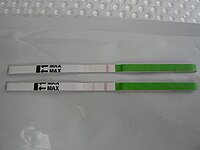
Photo from wikipedia
OBJECTIVE To investigate whether deoxyribonucleic acid (DNA) methylation at birth and in childhood differ by conception using assisted reproductive technologies (ART) or ovulation induction compared with those in children conceived… Click to show full abstract
OBJECTIVE To investigate whether deoxyribonucleic acid (DNA) methylation at birth and in childhood differ by conception using assisted reproductive technologies (ART) or ovulation induction compared with those in children conceived without fertility treatment. DESIGN Upstate KIDS is a matched exposure cohort which oversampled on newborns conceived by treatment. SETTING New York State (excluding New York City). PATIENT(S) This analysis included 855 newborns and 152 children at approximately 9 years of age. INTERVENTION(S) None. MAIN OUTCOME MEASURE(S) DNA methylation levels were measured using the Illumina EPIC platform. Single CpG and regional analyses at imprinting genes were conducted. RESULT(S) Compared to no fertility treatment, ART was associated with lower mean DNA methylation levels at birth in 11 CpGs (located in/near SYCE1, SPRN, KIAA2013, MYO1D, GET1/WRB-SH4BGR, IGF1R, SORD, NECAB3/ACTL10, and GET1) and higher mean methylation level in 1 CpG (KLK4; all false discovery rate P<.05). The strongest association (cg17676129) was located at SYCE1, which codes for a synaptonemal complex that plays a role in meiosis and therefore infertility. This CpG remained associated with newborn hypomethylation when the analysis was limited to those conceived with ICSI, but this may be because of underlying male infertility. In addition, nine regions in maternally imprinted genes (IGF1R, PPIEL, SVOPL GNAS, L3MBTL, BLCAP, HYMAI/PLAGL1, SNU13, and MEST) were observed to have decreased mean DNA methylation levels among newborns conceived by ART. In childhood, hypomethylation of the maternally imprinted gene, GNAS, persisted. No CpGs or regions were associated with ovulation induction. CONCLUSION(S) ART but not ovulation induction was associated with hypomethylation at birth, but only one difference at an imprinting region appeared to persist in childhood.
Journal Title: Fertility and sterility
Year Published: 2021
Link to full text (if available)
Share on Social Media: Sign Up to like & get
recommendations!